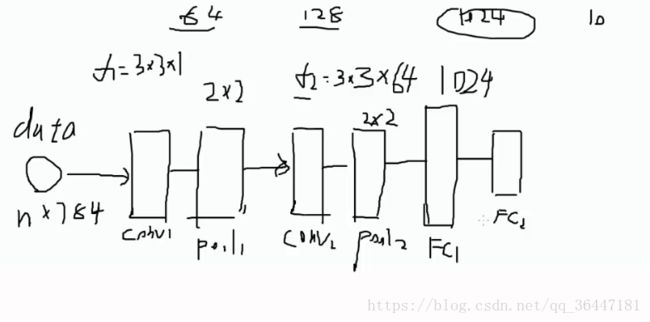Tensorflow学习笔记(五)——卷积神经网络实现
今天来实现tensorflow架构下的卷积神经网络,首先了解清楚我们要构建的网络架构,数据集还是用mnist,所以输入还是28X28。
建立的卷积神经网络架构是:卷积层->pooling层->卷积层->pooling层->全连接层1->全连接层2。
全连接层的尺寸公式:N = (W − F + 2P )/S+1
参数解释:
输入图片大小 W×W
Filter大小 F×F
步长 S
padding的像素数 P
因为定义的filter所以卷积层=(28-3+2X1)/1+1=28,池化选择2X2,所以经过两次卷积和pooling层,特征图的尺寸大小=7X7,
建完架构和设定好参数就可以开始写代码啦。代码如下:
一、导入好工具包和数据集
import numpy as np
import tensorflow as tf
import matplotlib.pyplot as plt
import input_data
mnist = input_data.read_data_sets('data/', one_hot=True)
trainimg = mnist.train.images
trainlabel = mnist.train.labels
testimg = mnist.test.images
testlabel = mnist.test.labels
print ("MNIST ready")二、定义各层参数
n_input = 784
n_output = 10
weights = {
'wc1': tf.Variable(tf.random_normal([3, 3, 1, 64], stddev=0.1)),
'wc2': tf.Variable(tf.random_normal([3, 3, 64, 128], stddev=0.1)),
'wd1': tf.Variable(tf.random_normal([7*7*128, 1024], stddev=0.1)),
'wd2': tf.Variable(tf.random_normal([1024, n_output], stddev=0.1))
}
biases = {
'bc1': tf.Variable(tf.random_normal([64], stddev=0.1)),
'bc2': tf.Variable(tf.random_normal([128], stddev=0.1)),
'bd1': tf.Variable(tf.random_normal([1024], stddev=0.1)),
'bd2': tf.Variable(tf.random_normal([n_output], stddev=0.1))
}![]() :卷积层的高斯初始化,分别对应h,w,输入深度(灰度就1彩色就3),得出多少特征图;
:卷积层的高斯初始化,分别对应h,w,输入深度(灰度就1彩色就3),得出多少特征图;
![]() :卷积层的高斯初始化,h,w,深度是对应的特征图,输出深度特征图。
:卷积层的高斯初始化,h,w,深度是对应的特征图,输出深度特征图。
![]() :全连接层的高斯初始化,h*w*上一层的特征图,输出的特征图。
:全连接层的高斯初始化,h*w*上一层的特征图,输出的特征图。
三、定义卷积架构
def conv_basic(_input, _w, _b, _keepratio):
# INPUT
_input_r = tf.reshape(_input, shape=[-1, 28, 28, 1])
# CONV LAYER 1
_conv1 = tf.nn.conv2d(_input_r, _w['wc1'], strides=[1, 1, 1, 1], padding='SAME')
#_mean, _var = tf.nn.moments(_conv1, [0, 1, 2])
#_conv1 = tf.nn.batch_normalization(_conv1, _mean, _var, 0, 1, 0.0001)
_conv1 = tf.nn.relu(tf.nn.bias_add(_conv1, _b['bc1']))
_pool1 = tf.nn.max_pool(_conv1, ksize=[1, 2, 2, 1], strides=[1, 2, 2, 1], padding='SAME')
_pool_dr1 = tf.nn.dropout(_pool1, _keepratio)
# CONV LAYER 2
_conv2 = tf.nn.conv2d(_pool_dr1, _w['wc2'], strides=[1, 1, 1, 1], padding='SAME')
#_mean, _var = tf.nn.moments(_conv2, [0, 1, 2])
#_conv2 = tf.nn.batch_normalization(_conv2, _mean, _var, 0, 1, 0.0001)
_conv2 = tf.nn.relu(tf.nn.bias_add(_conv2, _b['bc2']))
_pool2 = tf.nn.max_pool(_conv2, ksize=[1, 2, 2, 1], strides=[1, 2, 2, 1], padding='SAME')
_pool_dr2 = tf.nn.dropout(_pool2, _keepratio)
# VECTORIZE
_dense1 = tf.reshape(_pool_dr2, [-1, _w['wd1'].get_shape().as_list()[0]])
# FULLY CONNECTED LAYER 1
_fc1 = tf.nn.relu(tf.add(tf.matmul(_dense1, _w['wd1']), _b['bd1']))
_fc_dr1 = tf.nn.dropout(_fc1, _keepratio)
# FULLY CONNECTED LAYER 2
_out = tf.add(tf.matmul(_fc_dr1, _w['wd2']), _b['bd2'])
# RETURN
out = { 'input_r': _input_r, 'conv1': _conv1, 'pool1': _pool1, 'pool1_dr1': _pool_dr1,
'conv2': _conv2, 'pool2': _pool2, 'pool_dr2': _pool_dr2, 'dense1': _dense1,
'fc1': _fc1, 'fc_dr1': _fc_dr1, 'out': _out
}
return out
print ("CNN READY")tf.nn.max_pool(value, ksize, strides, padding, data_format='NHWC', name=None)中四个数值的解释:
value是一个四维的输入:batch, height, width, channels。输入经过卷积和relu层的_conv1,
_fc_dr1 = tf.nn.dropout(_fc1, _keepratio):是随机杀死一些节点,_keepratio是比例的意思
ksize[1,2,2,1]:batchsize维度,height,width,步行strides
四、在mnist数据集上验证一下准确率
init = tf.global_variables_initializer()
sess = tf.Session()
sess.run(init)
x = tf.placeholder(tf.float32, [None, n_input])
y = tf.placeholder(tf.float32, [None, n_output])
keepratio = tf.placeholder(tf.float32)
# FUNCTIONS
_pred = conv_basic(x, weights, biases, keepratio)['out']
cost = tf.reduce_mean(tf.nn.softmax_cross_entropy_with_logits(_pred, y))
optm = tf.train.AdamOptimizer(learning_rate=0.001).minimize(cost)
_corr = tf.equal(tf.argmax(_pred,1), tf.argmax(y,1))
accr = tf.reduce_mean(tf.cast(_corr, tf.float32))
init = tf.global_variables_initializer()
# SAVER
print ("GRAPH READY")
sess = tf.Session()
sess.run(init)
training_epochs = 15
batch_size = 16
display_step = 1
for epoch in range(training_epochs):
avg_cost = 0.
#total_batch = int(mnist.train.num_examples/batch_size)
total_batch = 10
# Loop over all batches
for i in range(total_batch):
batch_xs, batch_ys = mnist.train.next_batch(batch_size)
# Fit training using batch data
sess.run(optm, feed_dict={x: batch_xs, y: batch_ys, keepratio:0.7})
# Compute average loss
avg_cost += sess.run(cost, feed_dict={x: batch_xs, y: batch_ys, keepratio:1.})/total_batch
# Display logs per epoch step
if epoch % display_step == 0:
print ("Epoch: %03d/%03d cost: %.9f" % (epoch, training_epochs, avg_cost))
train_acc = sess.run(accr, feed_dict={x: batch_xs, y: batch_ys, keepratio:1.})
print (" Training accuracy: %.3f" % (train_acc))
#test_acc = sess.run(accr, feed_dict={x: testimg, y: testlabel, keepratio:1.})
#print (" Test accuracy: %.3f" % (test_acc))
print ("OPTIMIZATION FINISHED")得出结果:
